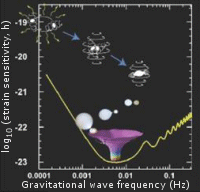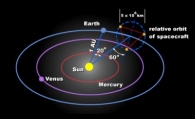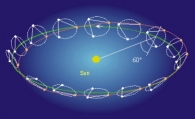Summary
LISA's low-frequency range is inaccessible to ground-based interferometers due to local gravitational noise arising from atmospheric effects and seismic activity. Ground-based interferometers are also physically limited in length to a few kilometres, restricting their coverage to a frequency range that includes events such as supernova core collapses and binary neutron star mergers. In the low-frequency band of LISA, sources are well known and signals are stable over long periods (many months to thousands of years). LISA will detect signals from numerous astronomical sources with signal-to-noise ratios of 50-1000 for MBHs, which will allow determination of the internal parameters of their source.
As the 3-spacecraft constellation orbits the Sun in the course of a year, the observed gravitational waves are Doppler-shifted by the orbital motion and amplitude-modulated by the non-isotropic antenna pattern of the detector. This allows determination of the direction of the source and assessment of some of its characteristics. For example, the source orientation can be derived if the signal is periodic and has a sufficiently large signal-to-noise ratio. Depending on the strength of the source, position determination can be achieved with a precision of up to an arcminute.
LISA Science
The excellence of LISA science has been summarized by one of the conclusions of the assessment of NASA's Beyond Einstein programme, recently completed by the National Reasearch Council (cfr. "NASA's Beyond Einstein Program: an architecture for Implementation" - Sep. 2007): "On purely scientific grounds LISA is the mission that is most promising and least scientifically risky. Even with pessimistic assumptions about event rates, it should provide unambiguous and clean tests of the theory of general relativity in the strong field dynamical regime and be able to make detailed maps of space time near black holes. Thus, the committee gave LISA its highest scientific ranking."
Einstein's theory of spacetime and gravity, general relativity, predicts that motions of mass produce propagating vibrations that travel through spacetime at the speed of light. These gravitational waves (as the vibrations are called) are produced abundantly in the Universe and permeate all of space. Measuring them will add an altogether new way to explore what is happening in the Universe: rather than studying the propagation and transformation of conventional particles and fields in spacetime, as all science has done up to now, LISA will sense vibrations of the fabric of spacetime itself. Studying this new form of energy will convey rich new information about the behaviour, structure, and history of the physical universe, and about physics itself. When gravitational waves become observable they will provide a new and uniquely powerful probe of the extremes of spacetime, from the Big Bang to black holes, to address the deep questions that have emerged in Einstein's vision of the cosmos: what powered the Big Bang, what happens to space and time in black holes and what is the mysterious dark energy accelerating the expansion of the Universe?
There are five types of gravitational wave sources that are expected to be detectable in the frequency band from 0.1 to 100 mHz where LISA is expected to have a usable sensitivity. Those are: inspiralling and merging massive black holes (103 to 107 solar masses), stellar-mass compact objects spiralling into supermassive black holes in galactic nuclei, close binaries of compact objects, and possibly backgrounds and bursts from cosmological and/or astrophysical sources.
 |
|
The LISA strain sensitivity curve |
These strong signals convey detailed information addressing a wide range of science: the history of galaxies and black holes in the Universe; general relativity itself and the behaviour of spacetime; precision measurements of the Universe as a whole; the physics of dense matter and stellar remnants; and possibly new physics associated with events in the early Universe or relics predicted in string theory. This science and these sources are qualitatively different from the science and sources of ground-based gravitational wave detectors. A space-based instrument can detect gravitational radiation with much lower frequencies, and the Universe happens to offer the richest array of sources at those lower frequencies.
The LISA strain sensitivity curve in the above image shows the approximate frequency range and strain amplitude of three categories of sources: massive black hole inspiral, ringdown and merger (uppermost source); ultracompact Galactic binaries (middle source); capture of stellar mass compact object by massive black holes (lower source).
Science Objectives
The table hereafter illustrates the LISA science objectives and the supporting science investigations. Each science investigation will lead to an observation of one or more of the anticipated source types.
| Science Objectives | Science Investigations |
| Understand the formation and growth of massive black holes | Search for a population of seed black holes at early epochs |
| Search for remnants of the first (Population III) stars through observation of intermediate-mass black hole captures, also at late epochs | |
| Trace the growth and merger history of massive black holes and their host galaxies | Determine the relative importance of different black hole growth mechanisms as a function of redshift |
| Determine the merger history of 1×104 to 3×105 solar mass black holes from the dawn of galaxies (z~30) to the era of the earliest known quasars (z~6) | |
| Determine the merger history of 3×105 to 1×107 solar mass black holes at later epochs (z<6) | |
| Explore stellar populations and dynamics in galactic nuclei | Characterize the immediate environment of MBHs in z<1 galactic nuclei from EMRI capture signals |
| Study intermediate-mass black holes from their capture signals | |
| Improve our understanding of stars and gas in the vicinity of Galactic black holes using coordinated gravitational and electromagnetic observations | |
| Survey compact stellar-mass binaries and study the structure of the Galaxy | Elucidate the formation and evolution of Galactic stellar-mass binaries: constrain the diffuse extragalactic foreground |
| Determine the spatial distribution of stellar-mass binaries in the Milky Way and environs | |
| Improve our understanding of white dwarfs, their masses, and their interactions in binaries and enable combined gravitational and electromagnetic observations | |
| Confront General Relativity with observations | Detect gravitational waves directly and measure their properties precisely |
| Test whether the central massive objects in galactic nuclei are the black holes of General Relativity | |
| Make precision tests of dynamical strong-field gravity | |
| Probe new physics and cosmology with gravitational waves | Study cosmic expansion history, geometry and dark energy using precise gravitationally calibrated distances in cases where redshifts are measured |
| Measure the spectrum of, or set bounds on, cosmological backgrounds | |
| Search for unforeseen sources of gravitational waves |
Detecting gravitational waves
LISA is a gravitational wave detector based on an interferometer. It measures time varying strains in space-time by interferometrically monitoring changes in baselines millions of kilometres long. The mission concept requires two basic functions:
- undisturbed masses to act as the endpoints of the baselines
- a measurement system to monitor changes in the lengths of the baselines
The disturbance of the masses must be sufficiently small that the resulting motions are less than the apparent length changes associated with gravitational waves to be detected. Likewise, the measurement system must be able to detect those apparent length changes.
The baselines are defined by three spacecraft orbiting the Sun. A key feature of the LISA concept is that there exist orbits that do not require station-keeping to maintain a near-equilateral triangular formation a fixed distance from the Earth for the duration of the mission. The spacecraft at the corners house interferometry equipment for measuring changes in the baselines and ‘proof masses’ which define their endpoints.
The proof masses are protected from disturbances by careful design and "drag-free" operation. In drag-free operation, the mass is free-falling, but a housing around the proof mass senses the relative position of proof mass and spacecraft, and a control system commands the spacecraft's microthrusters to follow the free-falling mass. Drag-free operation keeps force gradients arising in the spacecraft from applying time-varying disturbances to the proof masses.
The distance measuring system is essentially a continuous interferometric laser ranging scheme. Lasers at each end of each arm operate in a "transponder" mode. A beam is sent out from one spacecraft to a distant one. The laser in the distant spacecraft is phase-locked to the incoming beam and returns a high power phase replica. When that beam returns to the original spacecraft, it is beat against the local laser. Variants of this basic scheme are repeated for all long baselines, and the lasers illuminating different baselines are also compared. Optical path difference changes, laser frequency noise, and clock noise are determined.
Achievable levels of disturbance on proof masses and achievable sensitivities of laser ranging system make is possible to obtain a useful measurement bandwidth in the frequency regime of 10-5 to 1 Hz. This band has many types and large numbers of gravitational wave sources, some likely very strong.
The three arms can simultaneously measure both polarizations of quadrupolar waves. The source direction is decoded from amplitude, frequency, and phase modulation caused by annual orbital motion of the antenna sensitivity pattern across the sky.
Technical Challenges
When LISA-related activity started at ESA following its selection as a cornerstone mission of the Horizons 2000 scientific programme in 1995, it was immediately obvious that several technology challenges were going to face the developers. Although all of LISA's technology existed in some form at the beginning of the development effort and no new "inventions" were required, an incremental performance increase and additional functionality from proven technology was required. This applies to the fields of micropropulsion, drag-free sensing and actuation, interferometric measurement systems, phasemeters, high-precision pointing mechanisms. Additionally, the challenge of LISA really comes in tying all these pieces together at the system level, more than in advancing individual technology items. Several Technology Development Activities were put in place, some are still ongoing and some are planned to start in the near future. Between the start of development and now, technology in the above fields has progressed enormously and much of it will be flight-tested on LISA's technology demonstration mission LISA Pathfinder, to be launched in 2015.
International Collaboration
LISA is an ESA/NASA collaborative project. An initial agreement between ESA and NASA on roles and responsibilities for the Mission Formulation phase was finalized in August 2004. It foresees joint ESA and NASA conduction of the Mission Formulation phase in order to achieve a baseline mission architecture that allows requirement specifications to be derived and interfaces to be clearly defined. It also includes a tentative share of responsibility for deliverables and services, to be reviewed prior to entering later project phases, that shows NASA providing the three spacecraft, the launch vehicle, operations, the use of the Deep Space Network and elements of the payload and ESA being responsible for the delivery of the complete payload and the three propulsion modules. An update of the current agreement is planned to start soon to formalize ESA and NASA roles and responsibilities for the Implementation phase.
The technology demonstration mission LISA Pathfinder is an ESA mission that will fly the US Disturbance Reduction System (DRS) package along with the European LISA Technology Package (LTP).
Current Status
In January 2005, following an open tender, an industrial contract was assigned to Astrium GmbH for the LISA Mission Formulation study, initially to last 24 months. Scope of the activity is to perform all system engineering activities leading to the consolidation of an overall baseline LISA mission architecture and design that allows ESA and NASA to finalize their agreement on roles and responsibilities and that allows the requirement specification documents to be prepared. Towards the end of the study, an interesting option was discovered that could bring simplification to the overall architecture. It was decided to extend the industrial contract of 18 months in order to analyze in detail this option.
The baseline mission design has been finalized at the Mission Architecture Review in October 2005. The industrial contractor is currently completing a trade-off on two possible implementations of the architecture option called "in-field-of-view guidance". The results will be presented at the Payload Architecture Review #2 at the end of October 2007, after which the baseline architecture will be finalized (in November 2007) and the requirement specifications will be prepared.
Technology development activities are ongoing for the Point-ahead Angle Mechanism - two parallel contracts have been assigned to TNO (NL) and to RUAG (CH). Additional activities will be started in Q1-08 for the Telescope characterization, the Optical Bench, the Optical Assembly articulation mechanism and the Adjustable Frequency Reference for Laser Stabilization.
LISA within the ESA Science Programme
LISA was selected in November 2000 as the third cornerstone mission of Horizon 2000 plus (now Cosmic Vision 2005-2015) to be implemented within the allocation of a Flexi-mission envelope as a collaborative mission with NASA.
In 2003, a financially affordable programme was reconstructed which resulted in a plan confirming both the LISA Pathfinder (LPF) and the LISA missions. At its November 2003 meeting, the Science Programme Committee (SPC) requested the Executive to make all efforts to maintain an equal partnership with NASA regarding the LPF/LISA missions within the allocated resources. In mid-2004, ESA and NASA reached a working agreement on mission share that provided the basis for initiating an industrial Formulation study.
In February 2007, the Executive presented to the Science Programme Committee a revised implementation plan for the Cosmic Vision (CV) 2015-2025 Programme. Within this revised plan, LISA was to move from the present planning window (CV 2005-2015) to within the next decade as a large mission of Cosmic Vision 2015-2025. The Cosmic Vision implementation strategy considers two classes of missions: Medium (M) missions and Large (L) mission concepts. It follows that LISA becomes candidate for launch as an L-class mission concept of CV 2015-2025 with the earliest possible launch window in 2020.
At its February 2007 meeting, the SPC unanimously approved the implementation of LISA as a Class-L mission candidate for the first launch opportunity (L1) in the Cosmic Vision 2015-2025 plan.


